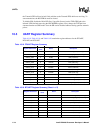
10-22 Intel® PXA255 Processor Developer’s Manual
UARTs
After the processor reads one character from the receive FIFO or a new start bit is received, the
character timeout indication interrupt is cleared and the timeout is reset. If a character timeout
indication interrupt has not occurred, the timeout is reset when a new character is received or the
processor reads the receive FIFO.
10.4.3.3 Transmit Interrupt
Transmit interrupts can only occur when the transmit FIFO and transmit interrupt are enabled. The
transmit data request interrupt occurs when the transmit FIFO is at least half empty. The interrupt is
cleared when the THR is written or the IIR is read.
10.4.4 FIFO Polled Mode Operation
When the FIFOs are enabled, setting IER[7] and IER[4:0] to all zeroes puts the serial port in the
FIFO polled mode of operation. The receiver and the transmitter are controlled separately. Either
one or both can be in the polled mode. In polled mode, software checks receiver and transmitter
status via the LSR.
10.4.5 DMA Requests
The FIFO data is one byte wide. DMA requests are either transmit data service requests or receive
data service requests. DMA requests are only generated in FIFO mode.
The transmit DMA request is generated when the transmit FIFO is at least half empty and
IER[DMAE] is set. After the transmit DMA request is generated, the DMA Controller (DMAC)
writes data to the FIFO. For each DMA request, the DMAC sends 8, 16, or 32 bytes of data to the
FIFO. The number of bytes to be transmitted is programmed in the DMA channel.
The receive DMA request is generated when the receive FIFO reaches its trigger level with no
errors in its entries and the IER[DMAE] is set. A receive DMA request is not generated if the
trigger level is set to 1.
The DMAC then reads data from the FIFO. For each DMA request, the DMA controller can read 8,
16 or 32 bytes of data from the FIFO. The number of bytes to be read is programmed in the DMA
channel.
Note: Do not program the channel to read more data than the FIFO trigger level.
If DMA requests are enabled and an erroneous character is received, the receive DMA requests are
automatically disabled and an error interrupt is generated. The erroneous character is placed in the
receive FIFO. If the UART was requesting a receive DMA transaction, the request is immediately
cancelled. This prevents the DMAC from attempting to access the FIFOs while software clears the
error.
When all the errors in the receive FIFO are cleared, receive DMA requests are automatically
enabled and can be generated when the trigger level is reached.


















